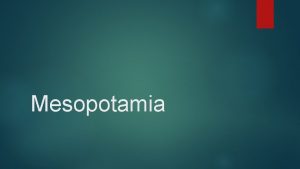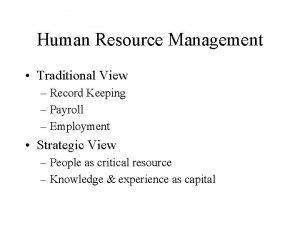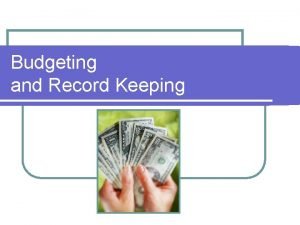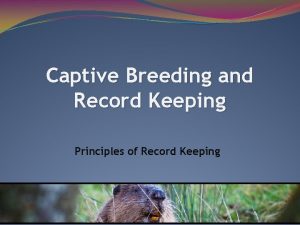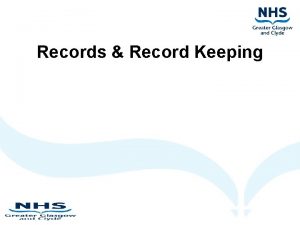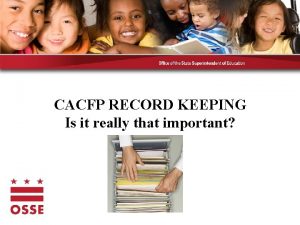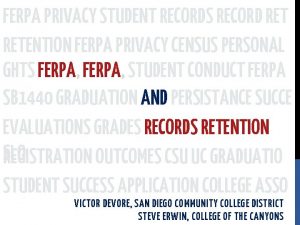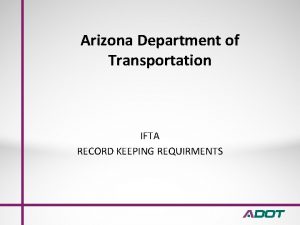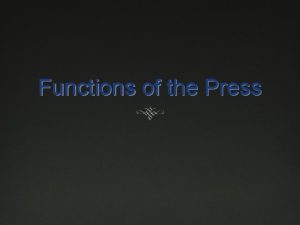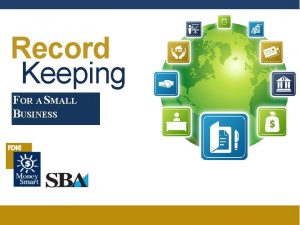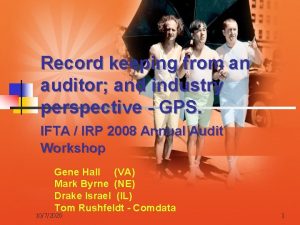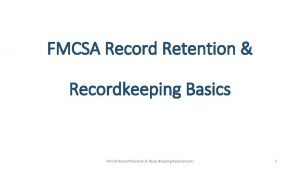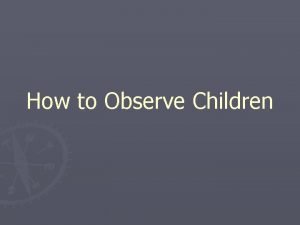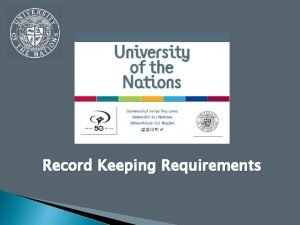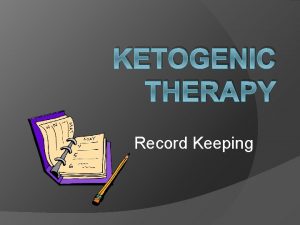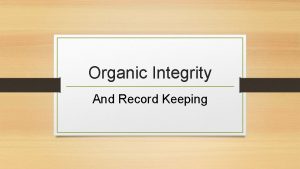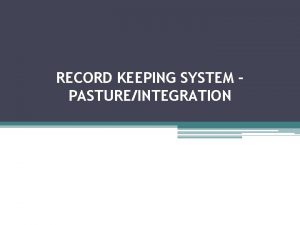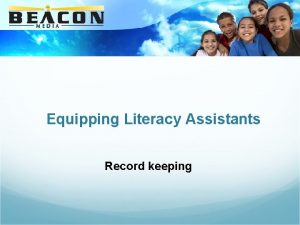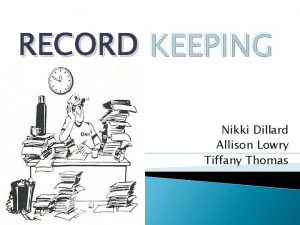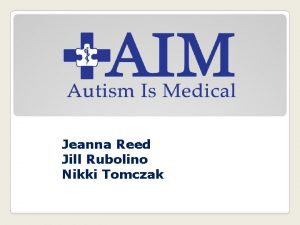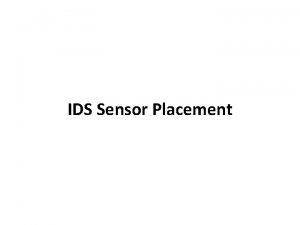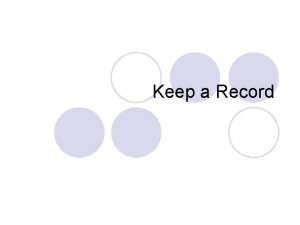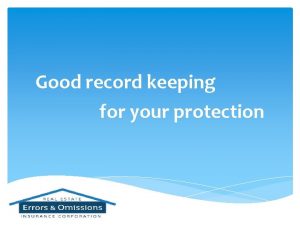Record keeping Placement preparation Nikki Williamson Lecturer in
















- Slides: 16

Record keeping Placement preparation Nikki Williamson – Lecturer in occupational therapy/Role emerging placement tutor School of Health and Human Sciences, University of Essex

Learning outcomes Following todays session you will be able to: § To consider information governance training in relation to record keeping § To identify and understand the importance of good record keeping § To identify the different aspects required within SOAP notes § To discuss a basic written SOAP note

What is record keeping? § § § Maintaining patient related information and contacts – handwritten notes and electronic records e. g. Patient files, medical notes, electronic systems (Care first, System One, ISIS, Rio) Smartcards – level of access for electronic records Maintaining secure patient notes and handling of notes Maintaining secure storage of patient notes Securing attachments in emails and storing electronic records Record keeping policies and guidelines within health, social care and professional bodies Do you share patient information?

Care records • “include any material that holds information regarding an individual, collected as part of their care provision”. • Data Protection Act (1998) • Handwritten, electronic, auditory or visual • Includes: • • computer or digital data Images Auditory or visual recordings Letters Notes Emails Text messages Duplicate copies

What is note writing? § § § Clear, concise, legible and easy to understand notes are essential but notes do not need to be lengthy Timely, signed, designation and date, errors should be legible Recording telephone contacts, patient face to face contacts, discussions with relevant professionals, referral forms, equipment requests, assessments, discharge summaries, information provided, decisions made in supervision Use of acronyms/agreed abbreviations only, avoid using abbreviations where possible Record keeping standards – local and professional guidance

SOAP notes “ SOAP notes are a highly structured format for documenting the progress of a patient during treatment and is only one of many formats that could be used by a health professional. They are entered in the patients medical records by health care professionals to communicate information to other providers of care, to provide evidence of patient contact and to inform the clinical reasoning process” www. physio-pedia. com/SOAP_Notes [accessed 06/01/15]

SOAP § History – Developed by Dr Lawrence Weed in the 1960 s at the University of Vermont as part of the Problem – orientated medical record (POMR) and therefore forms only one part of the documentation process. Health professionals began to use the four sections of SOAP as a format for writing notes § Advantages - Widespread use, general familiarity within healthcare, well organised documentation of findings with a natural progression to analysis and plan of action, improve communication among care givers § Disadvantages - Can be too concise, overuse of abbreviations and acronyms making it difficulty for non professionals to understand. Tendency for health professionals to collect information rather than assess/analyse the information. (Gateley & Borcherding, 2011)

What does SOAP mean? SOAP is an acronym for: S= Subjective (what the patient says about the problem, intervention e. g. pt reports, states, explained. . - their reported feelings) if unable to speak report on non-verbal communication O= Objective (The therapists objective, observations and treatment interventions carried out, what you observed, what you did) – Some therapists also use Rx (to represent treatment separate to observations) A= Assessment/Analysis (The therapists analysis of the various components of the assessment) P= Plan – How the treatment will be developed to reach the goals or objectives, what actions will be carried out e. g. Report back to therapist, order and provide equipment, phone call, referral. .

Why do we need to record patient contacts? § § § Legal and ethical responsibility – necessary under code of Ethics within the profession e. g. College of occupational therapists, Health and Care Professions Council. Record keeping guidance for occupational therapists (COT, 2010) Statistics/Audits to measure success of intervention and for research Following progress of colleagues work Identifying need for reviewing patients needs/achievements of goals

Why do we use SOAP notes? Essential to tracking the progress of a patients intervention/care § An effective form of writing progress notes recording: subjective, objective, assessment/analysis and plan § Organised note keeping format for recording all relevant information relating to patient contacts §

Tips and good practice: § Remember – your notes will be read by a health professional, either during the current intervention, or in several years time. Therefore, it is your responsibility to make sure that it is well written and countersigned (where appropriate). § Consider: self report of the patient, details of the intervention provided, equipment/technique used, changes in patient status, complications or adverse reactions, factors that changed the intervention, progression towards goals, communication with other providers of care, patient and family § If stating an exact phrase used by pt/family/professional this should be enclosed in quotation marks under (subjective) § Document every patient encounter (telephone call, discussion and face to face) § Review previous SOAP notes before next visit with a patient, this will improve the quality of patient encounter and guide you in collecting patient data similar to what has been recorded. § Patients SOAP notes should constitute a complete history of patients care

Common errors S= Passing judgement on a patient e. g. “Patient is over-reacting again” or documenting irrelevant information e. g. Patient is complaining about another staff member O= Limited information, not your subjective interpretation A= Assessment/analysis is vague e. g. “Patient is improving” – why? should explain reason behind this. This is an analysis of the subjective and objective P= The plan/future actions are not indicated, vague description of the plan e. g. “continue treatment”

Example of SOAP notes Opening line: OT (Bob Smith) initial interview, mobility assessment (bed to chair using rollator frame, walk 10 m) S: Patient reports difficulties in home care, in particular cleaning and shopping. Expressed concern of putting strain on son as a primary carer. Keen to get back to previous roles within home (mother, housewife) and visit friends O: Patient was polite and joking throughout. Patient required tactile cues for sit to stand moderate physical assistance to grasp rollator frame. Stood un-aided at rollator frame for 20 seconds. Reduced mobility and endurance observed – needing assistance after 2 metres. A: Patient is at risk of further falls. Would benefit from home visit to investigate risks in home environment P: Refer to physiotherapy for full mobility assessment, plan home visit with pt this afternoon, discuss with social work current/future package of care Borcherding S, Kappel C (2002)

Summary SOAP notes provide clear concise notes using an effective/organised format to record patient related information including: Subjective, objective, an assessment of intervention and identification of a plan to be able to track the progress of a patients intervention.

References and Resources References § Borcherding S, Kappel C (2002) The OTAs Guide to writing SOAP notes, Slack Incorporated § College of occupational therapy (2010) – Record Keeping Guidance 2 nd edition London: COT § Gately C and Borcherding S (2011) Documentation manual for occupational therapy: Writing SOAP Notes, New Jersey: Slack Incorporated § www. physio-pedia. com/SOAP_Notes [accessed 06/01/15] Resources § College of occupational therapy (2011) – Occupational therapy record headings for use in electronic care records § Weed L. L (1971) Medical records, medical education and patient care. The press of Western reserve University, 5 th edition § http: //ehow. com/how_5160224_write-therapy-soap. html [accessed 06/01/15] § College of occupational therapy (2005) – Record keeping COT briefing

Any Questions?
 Lecturer's name
Lecturer's name Nikki williamson
Nikki williamson Ot soap note example
Ot soap note example Record keeping and writing
Record keeping and writing Traditional record keeping
Traditional record keeping Record keeping and budgeting
Record keeping and budgeting Sssmzp
Sssmzp Legible meaning
Legible meaning Cacfp record keeping requirements
Cacfp record keeping requirements Ferpa record keeping requirements
Ferpa record keeping requirements Ifta record keeping requirements
Ifta record keeping requirements Ankle sprain soap note
Ankle sprain soap note Functions of the press
Functions of the press Record keeping requirements for small business
Record keeping requirements for small business Ifta record keeping requirements
Ifta record keeping requirements Fmcsa record retention & recordkeeping basics
Fmcsa record retention & recordkeeping basics Example of running record observation of a child
Example of running record observation of a child



